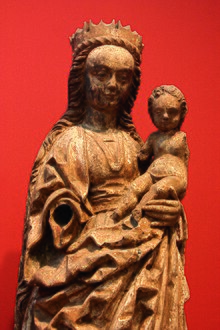Winser Madonna
The Winser Madonna is a Gothic crescent moon Madonna made of linden wood from around 1490. It stood 500 years ago in the Lady Chapel, which was in the tower. That was the entrance to the church of St. John the Baptist in Winsen (Aller), Lower Saxony . Today the Winser Madonna is owned by the Würth Collection and can be seen in the permanent exhibition in the Johanniterkirche , Schwäbisch Hall .
description
The figure is 127 cm high, 41 cm wide and 27 cm deep. She weighs about 40 kg. In the 19th century it was painted over with paint. In the State Office for Monument Preservation in Hanover, paint residues from an earlier version were found under the light brown paint. The hair is reddish brown. The face has red cheeks, red eyeliner, blue irises and black pupils. The inside of the coat is blue and the outside and the cord band of the crown are gold. The Winser Madonna is missing the Madonna's right arm as well as both arms and feet of the child, the prongs of the crown and the crescent horns. Wood-destroying insects are likely to have caused this loss.
“The Winser Madonna has soft, human features. She is not the Queen of Heaven, who rules in the clouds above the earth or the world, but is represented as the Mother of Jesus turned towards her, looking down to earth. Mary is shown as a very young Madonna with her garment falling in heavy folds. It stands on a half-crescent of the moon, which was the preferred base in northern Germany. In art history, this stand area is interpreted as a reference to transience or the earth. "
history
The Madonna was created by a master from Osnabrück around 1490 and was still in the Winser church during the Reformation. Then the traces are lost. It could have been removed from the church when the church was rebuilt in 1597 or during the Thirty Years War . Some suspect that it was kept somewhere in Winsen. In 1861 it came into the collection of the Welfenmuseum - there it appears in an inventory from 1863. In 1943 it was taken to the Blankenburg and then to the Marienburg for security purposes during the Second World War . By chance it was discovered in 1969 by the Winsen parish owned by the Welfenhaus. In 2005 the collector Reinhold Würth bought the Winser Madonna at an auction in London.
Timetable
- around 1490 creation of the sculpture
- Mention of the sculpture in a "Legacy of Ilse, the widow of Otto von Dageförde"
- During the Thirty Years' War the vaults and priechen were richly decorated with images, in front of which the imperial soldiers are said to have kneeled and prayed devoutly.
- On June 18, 1861, the day of remembrance of the Battle of Waterloo , King George V (Hanover) called for antiquities to be given for exhibition in the "Royal Welf Museum", which was then founded in 1862.
- In 1863 the Madonna appears in the handwritten inventory of the Welfenmuseum, later the Provincial Museum and, from 1933, the State Museum in Hanover
- After the Marienburg was secured against the effects of war , the State of Lower Saxony acquired the inventory of the Welfenmuseum in 1955 .
- In 2005 the Madonna was auctioned for the Würth Collection. Through the mediation of the Lower Saxony Ministry for Science and Culture, a contact was made with Reinhold Würth, who agreed to make the sculpture available to the Winsen parish of St. John the Baptist.
- From 2006 to 2014 the Winser Madonna was on loan to the parish of St. John the Baptist in Winsen an der Aller.
(Information according to the timetable on the website of the Evangelical Church in Winsen / Aller)
- The sculpture has been in the permanent exhibition in the Johanniterkirche in Schwäbisch Hall in Baden-Württemberg since 2015.
Individual evidence
- ↑ a b c d The Winser Madonna, page of the Ev. Winsen parish
- ↑ a b Press release of the Lower Saxony Ministry for Science and Culture from April 11, 2006
- ↑ This assessment is given by Simon Ziegler in the article in the Cellesche Zeitung "Winsen must say goodbye to the Madonna" on January 12, 2015.
- ↑ The Winser church council has argued that the ownership structure had not been clarified before the auction for 30,000 euros. Although the figure was moved from the State Museum to the Marienburg at the end of the Second World War, it did not become the property of the Welfenhaus. (According to Simon Ziegler in the article in the Cellesche Zeitung "Winsen must say goodbye to the Madonna" on January 12, 2015)
- ↑ Around the church. In: Evangelical Church Winsenaller. Retrieved September 9, 2019 .
- ^ Weber, C. Sylvia (ed.): New acquisitions of old masters in the Würth Collection. Schwäbisch Hall 2008. p. 113.
Web links
- Simon Ziegler, Madonna returns to Winsen, report in the Cellesche Zeitung on February 6, 2011
- Simon Ziegler, "It's a piece of Winser's history", report in the Cellesche Zeitung on February 7, 2011
- Report in the CZ on January 12, 15
- The Madonna von Winsen on the Winsen Tourism website
- The Madonna von Winsen on the side of the church
- Evangelical Lutheran Church of St. John the Baptist in Winsen on www.regioncelle.de

